Downtown Trolley Route Expands To Compton Starting March 14th
Tuesday’s post (Metro Makes Long-Needed Changes at 18th & Clark, Still Violates ADA) listed the many MetroBus route changes effective March 14th, one of which was the #99 Downtown Trolley. As mentioned in a July 2014 post, the Trolley will reach Union Station — and well-beyiond, as it turns out.
First, some history…
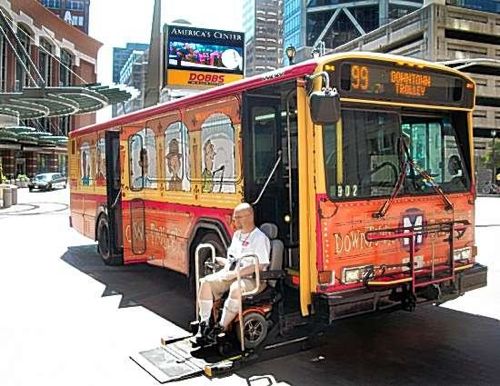
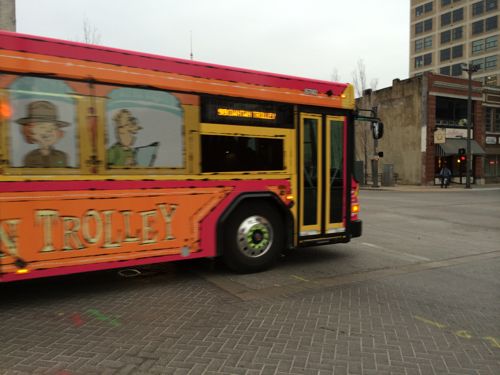
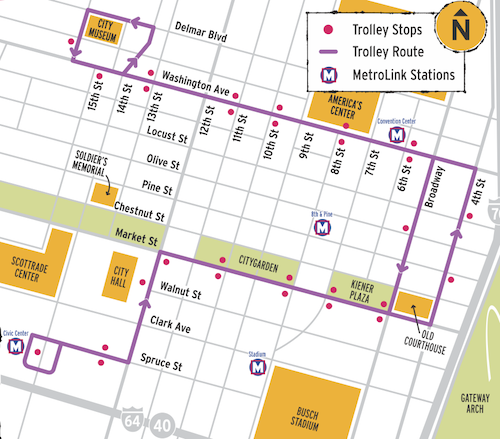
The route — until March 14th — had a loop at each end: City Museum and Civic Center MetroBus Center. Mostly in Downtown, a little in Downtown West (West of Tucker).
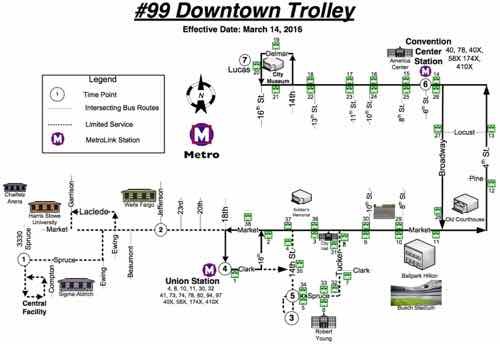
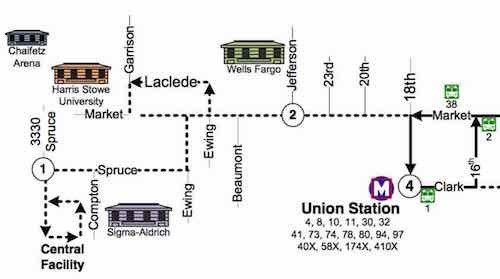
As you can see, it’ll now turn around at 18th & Clark, with some turn arounds still at Civic Center. The main difference is going much farther West on Market Street into Midtown. This will connect more businesses with the Central Business District (CBD). It’ll also show how bad this area is for pedestrians trying to use public transit — see Harris-Stowe State University Campus Disconnected From Adjacent City.
I personally would like to see the trolley not do the 14th/Delmar/16th loop around City Museum — but continue on Washington Ave to 18th or 20th — to reach Market. This would better serve Downtown West, a stronger connection with the CBD. Rather than them turning around on each end half would go clockwise, half counter-clockwise.
Looking forward to riding the new route, checking out the new stops.
— Steve Patterson
b
b
b
b
b
b
b
A longer route = longer travel times. Will Metro be adding more buses (and keeping the same frequency) or keeping the same number of buses (and making riders wait longer for the next bus)?
Or eliminate the time it sits idle at Civic Center?
Operators need (and deserve) breaks.
Yes the do, my focus for this post was the route — not frequency.
Seems kind of negligent to focus solely on the route and ignore the frequency. The frequency of the Downtown Trolley has slipped to the point where it diminishes the usefulness of the entire route. Why not just walk, instead?
Negligent? My focus was on the March 14th route changes. Period. The issue of frequency is valid — worthy of a full post on its own.
Perhaps negligent was too strong of a word, but when I saw that the route was being extended, my very first thought was “I bet they’re increasing the headways. I seriously doubt they’re adding another bus to the route to maintain the headways.”
The headways are becoming worse, from 14 minutes at peak to 20 minutes at peak. When the Downtown Trolley first began, peak headways were 10 minutes. I personally cannot wait until the eventual slide to a bus only every 30 minutes.
So, it’s becoming just another bus route, trying to offer a little service everywhere . . . a shuttle, by definition, runs frequently on a short route. Out at Lambert, every remote parking lot and “aiport” hotel offers a shuttle. And here’s how Denver does it (plus it’s “free”): http://www.rtd-denver.com/FREEMallRide.shtml and http://www.rtd-denver.com/FreeMetroRide.shtml
I can’t figure out the point of this. The trolley is meant for tourists, it hits the downtown hotels and attractions. I can’t figure what tourist is going to want to visit the no-man’s land west of Jefferson.
The trolley isn’t strictly for tourists. Since few bus routes enter the CBD it gets locals where they need to go. A Metro Board member is with Harris-Stowe. Wells Fargo likely helped with funding.
The extension of the #99 is due to the fact that the #4 route is being changed. Previously the #4 headed south from Natural Bridge on Jefferson.. then west on Olive.. south on Compton and east on Market.
Effective March 14th, the #4 will continue south on Jefferson to Market which is a much more direct and logical routing. To make up for that change, the #99 is being extended west to Compton.
OK, that makes sense. So it’s acting as a shuttle from Harris-Stowe to the Metrolink and all the bus lines that intersect downtown.
What this discussion illustrates is the need for a larger discussion on rationalizing Metro’s entire route system and operating structure. Running a bus every 30 or 60 minutes certainly benefits transit-dependent riders, but scares away choice riders. If your goal is to get people close to many destinations IF they’re willing to spend 1-3 hours making the trip, then the current system probably “works”. But if your goal is get people to give up their single-occupant vehicles and onto transit, providing frequent service to major destinations works a whole lot better – see what Houston did: http://www.citylab.com/commute/2014/05/houstons-plan-get-amazing-new-bus-system-no-new-money/9078/
I agree completely, Houston appears to be an innovative city based on this and other information I have seen. The failure to present a coherent alternative to what is existing transit is a serious failure of leadership in St Louis. Maybe they should consider hiring Jarrett Walker as a consultant.
Not only is it possible to design a more effective transit system for the same money, but St Louis needs to step up to the plate, particularly in areas like Paul McKee’s Northside. Leadership by public officials in the creation of public space, of shaping the city to accommodate transit and movement is nonexistent. This is true even when a major opportunity presents itself, as with the large open spaces encountered on the Northside.
.
The just announced project in the Central West End by Lawrence Group and Steve Smith at first glance seems to attempt the coordination of movement systems. I especially noticed the connection of the project to Forest Park and other areas of the city by bicycle and trail.
Perhaps Steve Smith should take over from McKee.
The point is, city officials are falling down on the job to insure integration of the city into a meaningful whole. Steve Smith demonstrates the approach, as does Houston.
No developer, these days, is going to look much beyond the boundaries of their own site, when it comes to transportation. They probably care about the nearest freeway interchange, and they may even care (a little bit) about the nearest public transit options, but they really don’t care about how people GET TO those access points, just that they do! Developers have no desire to spend their money on getting people TO their sites; heck, they expect the public to pay for some (much? all?) of the infrastructure ON their sites, through TID’s & TIF’s. So that leaves the creation and the maintenance of our transportation infrastructure to the public sector, for better or for worse, for both highways and public transit. It doesn’t matter if it’s Steve Smith, Paul McKee or George Vatterott, their interest, as in spending their own (or their future buyers’ or tenants’) money, ends at their property line.
The only time I’m aware of that a developer actually wrote a check to a transit agency was when Drury Inns paid RTD in Denver to add another span to a light rail bridge. And they did so just to increase the visibility of their property from the nearby freeway interchange; it had nothing to do with providing better transit access TO their property (and I personally think that they wasted their money!): https://www.google.com/maps/@39.5814331,-104.8778634,3a,75y,180h,90t/data=!3m6!1e1!3m4!1sFxuuDCK8MV_F6t1pl5962A!2e0!7i13312!8i6656
That is why the role of government is so important, it is the job of government to go beyond the boundaries of the developers site not only for transportation, but for all matters concerning the well being of the city and the proper integration of any development.
No one is asking developers to pay for transit.
As you point out with your link to Houston, it is entirely possible to design a better system without extra costs to the public.
The real problem is the opportunity to promote this integration and improve St Louis is being missed by city officials on the McKee project. If McKee does his usual garbage, the city will be set back 50 years.
The developers of the streetcar suburbs, of the late 19th and early 20th centuries DID pay for transit (streetcars), to get buyers out to their developments: http://www.livingplaces.com/Streetcar_Suburbs.html